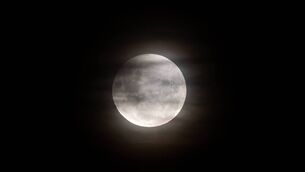We’ve done the right whale wrong
Then, in 1968, an international moratorium on commercial whaling came into force and the populations began to recover. Nowadays, minke whales are common in Irish waters, fin whales and humpbacks are regularly recorded and migrating blue whales are seen further out. Some species have fared better than others, but protection seems to have benefited almost all of them. The fortunes of one great whale, however, have not improved; the right whale, once very common, remains critically endangered. There are thought to be just a few hundred left in the North Atlantic.
The whalers considered this the ‘right’ whale to catch, hence the name. A slow swimmer, it ventured close to land. Trusting and friendly, the right whale allowed boats to approach, making it an easy target for the harpooners. Carcasses often sank before whalers could retrieve them, but the right whale’s body contains so much oil that it always stayed afloat. A fully grown animal could yield up to 20 tonnes of oil. The quantities of baleen, used to make items such as corsets, were also prodigious; the right whale’s enormous mouth, so big that it can’t be closed completely, has up to 500 baleen plates.
This plankton feeder swims with its mouth open in the manner of a basking shark. The tongue can weigh 1.5 tonnes. This stocky almost all-black monster has no dorsal fin. The ‘blow’, a spout of steamy air, is expelled through the two blow-holes in a characteristic ‘V’. Little is known of the right whale’s migration routes or its social organisation. The testicles of a mature bull might weigh a tonne, so it’s a ‘sperm competitor’ and unlikely to be monogamous. The female probably mates with every powerful suitor she encounters when in season, letting the sperm of the best man win.
Bones of right whales have been found in 3,500 year-old Eskimo middens. Norsemen hunted these animals 1,000 years ago, but Basque whalers, from the 11th century onwards, were the first to seriously deplete the stocks.
Having annihilated the species in the Bay of Biscay, the Basques moved further afield. Dutch whalers joined them and, by 1700, Europe’s right whale population had collapsed. Next, the whalers targeted the Atlantic coast of North America. By 1800, the population there had been decimated. In all, about 100,000 right whales were slaughtered during the 19th century. According to Hayden and Harrington’s Exploring Irish Mammals, only 18 right whales were landed at the Inishkea whaling station which opened in 1908. This and a station at Blacksod operated until 1914, but no right whales were caught after 1910. The species was given protection in 1935, but the decline continued. There have been only two sightings here during the 20th century, both of them at sea. The situation in the northern Pacific is equally depressing; the species, common up to the 1840s, is now exceedingly rare.
You might think, therefore, that there’s no chance of seeing a right whale, but you would be wrong. Paradoxically, the right is probably the easiest great whale to encounter but, to do so, you must go to South Africa. Between June and November, right whales come to Walker Bay, 80km east of Cape Town, to calve and probably to mate. Hermanus, the local town, is a Mecca for whale watchers. The number of whales varies. There were about eight adults and at least one calf present when I visited the bay last month, but up to 70 have been recorded together. The whales come close in under low cliffs and seem to perform for the crowd. There is no need to hire boats or endure sea-sickness; a pair of binoculars is all that’s required to watch the show.
Of course these are southern right whales, which most zoologists regard as a separate species to those of northern waters. Some experts go even further, separating the right whale into three species; Atlantic, Pacific and Southern.
A visit to Hermanus is an exhilarating experience but also a sad one; you become acutely aware of what we have lost. Thanks to the greed of the whalers we are denied these great shows off Ireland.













